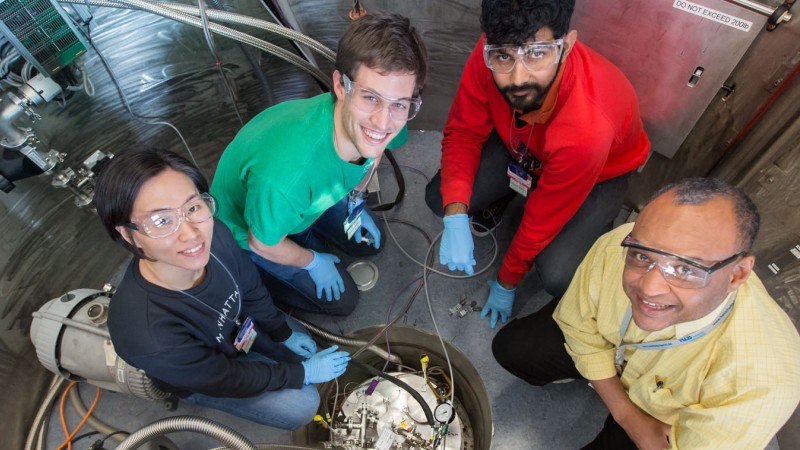Nanoconfined water is everywhere. Minerals, cells, living tissue membranes, synthetic water purification membranes, and countless other substances host water confined in spaces small enough to measure in nanometers. Studying the water dynamics in these materials, or nanopores, can lead to significant technological advances.
A team from the University of Minnesota is using neutrons to study nanoporous lyotropic liquid crystals, formed by the self-assembly of “soap-like” molecules. This team—composed of Dr. Mahesh Mahanthappa and several of his students—are using the BASIS instrument at Oak Ridge National Laboratory’s Spallation Neutron Source, SNS beam line 2, to study how water behaves in membranes.
“We are trying to measure water dynamics within model membrane systems to then use these insights to design better fuel cells for ion transport,” said student Grayson Jackson.
Using surfactants, or “soaps,” the team assembled materials that confine water into small pores. Capturing this water sample enables the users to conduct a variety of tests and measure the results. For example, changing the size of the nanoconfined channel can affect the water dynamics and thus provide relevant data.
“If we add more water in, our channel gets bigger and usually the dynamics get faster,” Jackson explained.
By varying the chemical structures of the surfactants and the amount of water available to induce the self-assembly of these materials, the team can access various nanopore shapes and sizes. Altering these factors also helps the team study how water dynamics change depending on the pore structure and its chemical functionalities. In addition to the scientific implications, results from these studies hold promise for improvements in everyday technology.
“A good example would be something like a lithium ion battery in a laptop or for a fuel cell to try and transport protons through a membrane,” Jackson said.
Previous research indicates that nanoconfined water directly affects proton conductivity and transport, and the team hopes to investigate the extent of this relationship. In a discovery that supports this theory, the Mahanthappa group recently measured high ion conductances through water-filled nanochannels in lyotropic liquid crystals. The SNS facility’s resources were vital for identifying the tangible results of this experiment.
“The high flux and energy resolution afforded by the BASIS instrument at SNS, coupled with our fantastic collaborative interactions with its beamline scientists, have enabled our studies that seek to uncover new molecular design principles for ion transporting membranes for myriad energy applications,” Mahanthappa said.
A stronger grasp on the connection between nanoconfinement and water dynamics could lead to the development of new ion transporting membranes, which are fundamental components of fuel cells and other electrochemical devices. Such a breakthrough would be beneficial for both chemists and consumers.
This research was funded under U.S. Department of Energy, Basic Energy Science contract DE-SC0010328.
SNS is a Department of Energy Office of Science User Facility. UT-Battelle manages ORNL for the DOE’s Office of Science. The Office of Science is the single largest supporter of basic research in the physical sciences in the United States, and is working to address some of the most pressing challenges of our time. For more information, please visit http://science.energy.gov/. —Elizabeth Rosenthal





